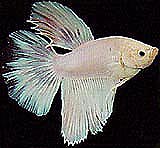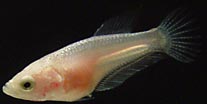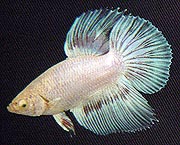 +
+  =
=

SECOND SPAWN: An account of spawning two white opaque fantail bettas
(Click on Bettas to return to the main betta page or on main site to browse 70 topics ranging from exotic kaleidoscope designs to the strange world of lucid dreaming.)
Below
are the spawning pair, Flame and Bianca, and one of the fry.
 +
+  =
=
This
is an enlarged picture of a 6-week old fry. In reality it's 2/3-inch long.
1. February 20: I introduced Flame and Bianca, my two white opaques, to the spawning tank. I'll release Bianca, the female, on 22 February. Please check back often as things should start to move quickly after that. This promises to be an interesting spawn since Flame was an egg-and-fry eater during his first spawn. Because of that, I've developed three different egg-and-fry raising techniques that do not require a male fish. Flame will get 1/4 of the eggs to see if he's got his act together while the remained eggs will be divided between the three techniques to see which, if any, works. Wish me luck!
2. February 21: Impatience got the better of me and I released Bianca into the spawning tank. After a day of aggressive courting, they began to spawn at 10 am on 22 Feb. Bianca started dropping eggs at 10:25 am and the spawn was over at 2:30 PM. So far so good. Flame has made a good strong bubble nest and filled it with hundreds of eggs. He seems to be attending them well... but then he did that during the first spawn and ended up eating all but a few of them. The small number that hatched also ended up getting eaten. I'm doing two things differently this time: I'm giving him food and 150 eggs were collected using a shallow container covered with a screen under the bubble nest. These eggs have been divided into four different incubating schemes that don't require fatherly intervention. Check back Monday night and I should have the results of how effective fatherless egg-hatching is.
One of the hatching techniques enables close inspection of the eggs. What I noticed is that ninety percent of them look alike, the remaining ten percent are fifty percent larger, whiter, and more opaque. It'll be interesting to see if it turns out the smaller, paler eggs are ones that didn't get fertilized.
3. February 23: The first eggs with protruding tails began to fall from the nest at 10 PM, 23 February. This was only 36 hours after they were laid and I'm concerned because I read somewhere that if the eggs develop too quickly there is a greater chance of weak or deformed fry. Tank temperatures were maintained at 79.5 degrees +/- 0.5 degree, which isn't excessive so the early hatching isn't the result of too high a water temperature.
By the way, since this male had already demonstrated a willingness to eat eggs and fry, I didn't think giving him food would simulate his appetite any more so I added brine shrimp to the tank. I figured that if he had a snack from time to time, he might not eat eggs or fry. It was a wasted jesture. He completely ignored the shrimp, even when they swam right into his face.
By the morning of 24 Feb., there were over 100 fry laying on the bottom of the tank. Many where making attempts to swim to the surface. The male, as in the first spawn, appears inept as far as getting the fry back into the nest. He spits them out but they almost never stick, even when they are immobile.
The four different techniques used to hatch the eggs without male intervention failed. Only one, eggs in 1/2 inch of water, had any fry hatch and then, just a few. Please go to the fatherless egg and fry raising page for details on this experiment.
Anyway,
there are twenty times the number of fry this spawn as in the first
so I'm hopeful some of them will survive. Please check back around
February 27 and I should have a final surviving fry count, the
conclusion of the fatherless egg/fry raising experiment, and the
results of the baby brine shrimp-feeding test. See you then!
4. February 26 - Mystery of the disappearing fry!: What happened?! On the evening of 25 Feb. I estimated there were 250 fry in the spawning tank. Most of them had nudged their heads along the waterline or were laying on the bottom of the tank near the edges. Granted, they weren't very active, they spent 90 percent of their time laying on the bottom, but they all regularly swam up to the surface and several were starting to swim horizontally. The following morning I could only count twenty fry! The others weren't dead... they were gone! No bodies, no nothing. The male betta had long been taken out and there's nothing else in the tank so they couldn't have been eaten. It's inconceivable that they could have died and completely decomposed in 8 hours. Where did they go? This is very X-File-ish. I've read about sudden die offs of fry but never about massive fry abductions. If anyone out there knows what's going on, I'd really appreciate their sending me a note that explains this. Thank you.
5. February 27 - Something new about fry foods and disappearing fry update: Today marked the third day since the fry hatched. Their yoke sacks are gone so I gave them a sampling of live foods to see which they could eat and which they preferred; baby brine shrimp, vinegar eels, or microworms. So far I haven't seen any of the fry eating, but have observed a couple of things about the food. First is that baby brine shrimp seem to all come in one size. If the fry can't eat one, they won't be able to eat any of them. Second, unlike baby brine shrimp, vinegar eels and microworms come in a wide range of sizes. The smallest are almost microscopic where the largest are, if one worm could be rolled up into a tight bundle to be the same shape as a baby brine shrimp, about the same volume as a baby brine shrimp. This indicates that using eels or worms for fry food has a great advantage: the size variation allows fry to select the size food they can handle.
One thing that I don't recall reading in any of the sites I visited is a warning that fry spend 95 percent of the time laying around looking dead during the first two days. This can be disconcerting to first-time breeders like myself.
The problem with the disappearing fry still hasn't been solved but fortunately, it may not be as bad as I first feared. Now that they are into their third day, the fry have started swimming horizontally and are much more active. I'd estimate that there are somewhere between 25 and 50 fry alive and active. Still, I wish I knew what happened to the other 200 that vanished overnight.
6. March 2: The mystery of the disappearing fry seems to be simply that they were hiding over by the filter and heater and I couldn't see them. As of this morning, I'd estimate that there are at least 100 fry in the tank. Some of the things that surprise me are that some of the fry still haven't developed their swim bladders and are continually shooting up to the surface then gliding back down to the bottom of the tank, all of the fish still spend a lot of time laying on the bottom of the tank, some of the fry are already twice as big as the others - the smaller ones are mostly the ones that haven't developed their swim bladders, and that fry will eat as many brine shrimp as are in the tank - even if they explode from it.
7. March 14 update: It's heartening to know that in spite of my first-time blunders the fry appear to be growing and doing well. The spawn is 19 days old and the only fry that have died in the last week are two that accidentally got siphoned while I was cleaning the bottom of the tank. There was one fish that had a small while spot on its tail that looked like ick or a fungus. I carefully checked all the fish several times a day and it wasn't there the previous night so it had to have been a new development. I isolated the fry, gave it a buckshot dosing of Aquari-Sol, treated the rest of the fry tank with an extra dose of Aquari-Sol, and ran the temperature up to 85 degrees for eight hours to drive any spores off their bodies. The white spot on the isolated fish fell off after two hours, leaving a chunk missing out of the tail. Other than that the fry appeared healthy (was swimming and eating) so I released him back into the tank after eight hours. That was three days ago and no signs of the disease have appeared in him or any of the other fry. I think I may have dodged a bullet on this one.
I continue to feed them on mainly vinegar eels with baby brine shrimp as a treat every other day. At nineteen days old, the fry average 1/4-inch long. There are two fry that are half this size, five that are about 0.2-inches long, and the rest are same size. From what I've read about other spawns, this sounds very uniform.
I've been vacuuming the bottom of tank clean every three days and gently adding water so that the tank is now completely full. I've noticed that whereas at first a feeding of vinegar eels would last a full day, now the same size feeding is gone in four hours.
A few of the larger fry are starting to show hints of white at the base of their tails. Also, many have started growing their dorsal fins. The fry are also much more active than they used to be. They sleep on the bottom of the tank but spend 50 percent of the day swimming around. This increased activity makes them much more entertaining to watch.
March 21 update: I lost two fry due to obvious physical deformities. That puts the spawn at 56 fry. They all seem to be doing well. Too well, in fact. They're eating me out of vinegar eels! Most of the fry are 0.30-inches long and looking more like fish than tadpoles. They are all showing hints of white opaque streaks at the base of the tail.
March 24 update: I named my first fry! He's called Dizzy because one day while racing across the fry tank he careened into the filter cutting a gash in his forehead. Now he spends a lot of time swimming in circles. He also looks a little cross-eyed.
The fry continue to eat and grow with the largest being half an inch long. The smallest are stuck back at one-quarter inch. There's no shortage of food so I can only assume that some fry are genetically predisposed to be small.
I lost a couple to deformities and believe the spawn now stands at 53 fry.
All of the fry are showing some traces of pale white in their fins. This is easiest to see by shining a flashlight on them.
March 30 update: DISASTER STRIKES!!! Even as I write these words, a bacterial infection is ripping through the spawn. Fifteen fish died in 48 hours. The infection looks like a roughened red spot on the forehead. I'm treating with tetracycline and can only wait and hope. Wish me luck.
April 3 update: Repeated 100-percent water changes and medicating with tetracycline seems to have stopped the bacterial infection, but not before a horrible cost. One-half of all the fry died. I'm now down to only twenty-eight. The good news is none have died in the last 48 hours and they all appear healthy.
I believe the severity of the infection resulted from my not being able to recognize it when I first saw it. If you look back at the March 24 update, I mention that one fish looked like her had struck himself in the head. I believe that this was really the first case of the bacterial infection. Because I failed to recognize it, the infection spread throughout the tank unabated for six days. By that time it was so back many of the fish had been infected to a fatal degree.
I'm not convinced the tetracycline cured the sick fish because every fry with visible signs of the disease seems to have died. Rather, all the medication did was prevent the rest of the fish from becoming infected and stopped the bacterial from continuing to grow in the tank.
Besides teaching me what a bacterial infection looks like, this experience also taught me the value of prevention. My next spawn will be kept much cleaner and I will add some methylene blue to the water as a bacterial preventative.
Those fry that survived have earned their reward. I started feeding them grindal worms at the end of the fifth week. They seem to love them. As of April 3, the fry are 39 days old and largest are one-half an inch long. None of them are showing very much color but I've heard that is typical for white opaques. I've noticed several of them gulping air from the surface so it appears that their labyrinth systems are starting to work.
NEW!!! May 1 update! After ten days with no fish dying, two passed away one night for no apparent reason. No others have died in the following two weeks so I assume it wasn't an illness but rather genetic flaws that took them. Speaking of genetic flaws, of the remaining 24 fish, one has a deformed mouth, one has a sideways kink in its spine near the tail, one has a deformed dorsal fin, and two have mildly humped backs.
One fish picked up a red fuzzy patch near the base of his tail. The color suggests a bacterial infection whereas the fuzziness suggests fungus. I isolated it and am treating it with Neosufex, a broad spectrum anti-fungal/anti-bacteria medication. Four days into the treatment the fuzziness and color seem to be fading. None of the other fish appear to be infected.
At seven weeks of age many of the fry began showing some of the red coloring inherited from their parents. Now nine weeks old, almost all of them are developing touches of red in the fins.
Pictures of the two best fish from this spawn


Both of the pictures above are of the same fish: Flame Junior. The one on the left shows his fin shape and the one on the right more accurately captures his coloring. This is my favorite from the spawn: he's beautiful and very spunky. The picture on the right was a lucky get. I've never again been able to duplicate the lighting that enabled me to capture the red in his fins.

Meet Whitey. He's slightly smaller than Flame Junior. He is absolutely pure white. There isn't the tiniest spot of red anywhere on him. Also, at full display his tail fans out to 150 degrees, which classifies him as a super-delta... just short of a Halfmoon.
The females didn't come out so well. One is extremely clean with one small red spot on her tail. Another has two very small spots but a better body shape. The rest are weaker versions of Flame Junior.
If I decide to breed any of the fish from this spawn, It'll probably be Whitey and the cleanest female. It would be interesting to see if that spawn resulted in a higher percentage of pure-white fish.